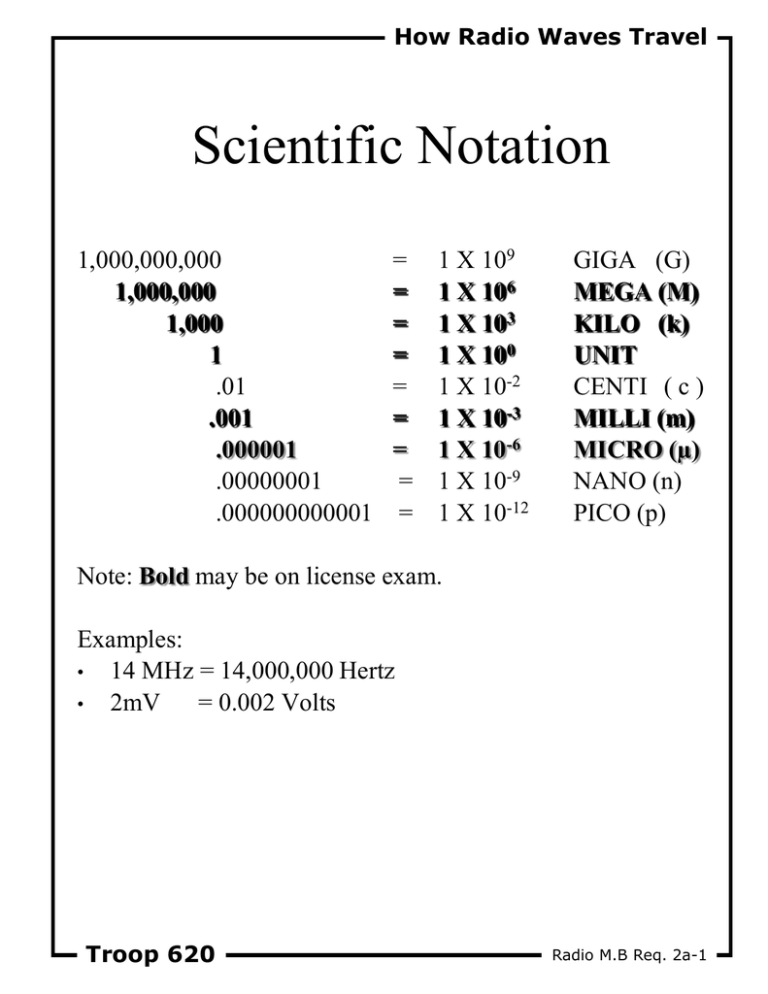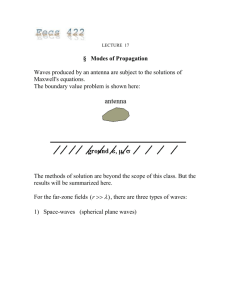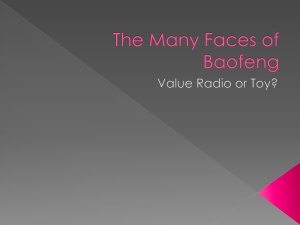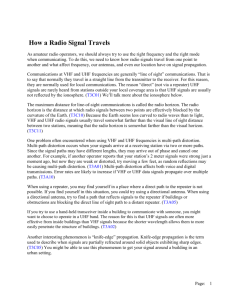Radio merit badge Requirement 2A
advertisement

How Radio Waves Travel Scientific Notation 1,000,000,000 1,000,000 1,000 1 .01 .001 .000001 .00000001 .000000000001 = = = = = = = = = 1 X 109 1 X 106 1 X 103 1 X 100 1 X 10-2 1 X 10-3 1 X 10-6 1 X 10-9 1 X 10-12 GIGA (G) MEGA (M) KILO (k) UNIT CENTI ( c ) MILLI (m) MICRO (µ) NANO (n) PICO (p) Note: Bold may be on license exam. Examples: • 14 MHz = 14,000,000 Hertz • 2mV = 0.002 Volts Troop 620 Radio M.B Req. 2a-1 How Radio Waves Travel Frequency Frequency is the number of AC cycles/second. Hertz (Hz) is the unit for cycles per second. 60 Hz is 60 cycles per second. 146MHz is 146,000,000 cycles per second Audio Frequencies (AF) = 20 Hz to 20,000 Hz. Communication voice is 300 to 3,000 Hz. (~ 3 KHz.) 300 Hz is a low, deep sound of a man’s voice 3000 Hz is a very shrill sound Radio frequencies (RF) over 20,000 Hz. High Frequency (HF) 3 to 30 MHz Very High Frequency (VHF) 30 to 300 MHz Ultra High Frequency (UHF) 300 to 3000 MHz Electromagnetic waves travel @ speed of light. Distance a radio wave travels in 1 cycle is its wavelength Wavelength = (Speed of Light) / (Frequency) Example: 14MHz = 14,000,000 Hz. Its wavelength is (3*108 meters per second) / (14,000,000 Hz) = about 20 meters Troop 620 Radio M.B Req. 2a-1 How Radio Waves Travel Radio Spectrum Troop 620 Radio M.B Req. 2a-1 How Radio Waves Travel VHF and UHF Propagation All radio signals travel out to the horizon, just like light, if they are not refracted (bent) or reflected. VHF and UHF signals are usually not refracted or reflected. So, if they are most useful for talking to stations that you can see. But, occasionally, obstacles can refract a tiny bit of signal and it can still be received: Troop 620 Radio M.B Req. 2a-1 How Radio Waves Travel VHF and UHF Propagation VHF and UHF waves can also reflect (bounce) off of large metal objects like airplanes or metal buildings. VHF waves can also bounce off of meteors Signals could be strong or weak UHF Frequencies are usually to high to bounce off of meteors Lower VHF frequencies, such as the 6 meter ham band (50 MHz) work best Communication does not last long. When the meteor disappears from sight, communication disappears soon afterwards Sometimes humidity and thunderstorms will scatter VHF and UHF a little bit and communication of several hundred miles is possible Troop 620 Radio M.B Req. 2a-1 How Radio Waves Travel HF Propagation HF signals can bounce off of an area of the atmosphere called the ionosphere Communication for thousands of miles is possible The ionosphere is between 60 and 250 miles about the surface of the earth When the weather in the ionosphere is severe, HF radio waves can easily bounce off of it Sometimes they can bounce between the earth and the ionosphere several times and worldwide communication is possible The weather in the ionosphere is the most severe when there are many spots on the sun. The number of sunspots vary daily and, in general, in an 11 year cycle. This is similar to seasons (spring, summer, fall, and winter) on earth. But, sun activity can vary greatly on a day to day basis. Troop 620 Radio M.B Req. 2a-1




